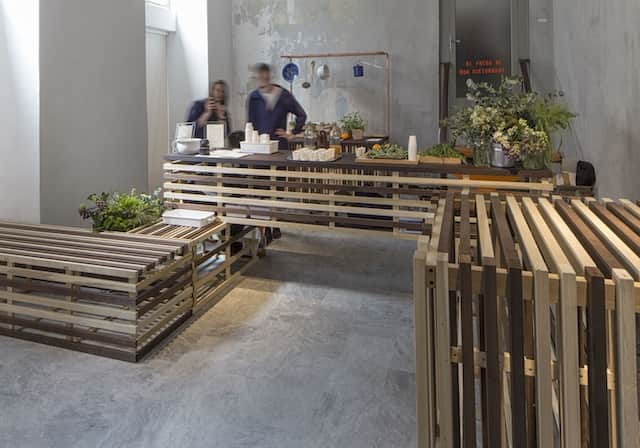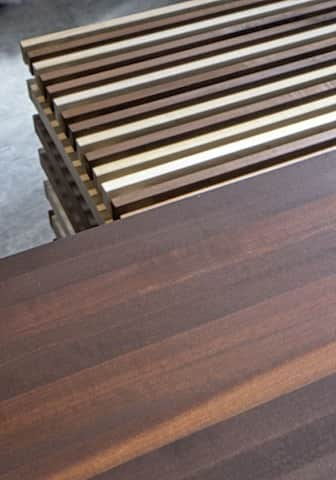For this year’s Salone del Mobile in Milan, the international and influential style magazine Wallpaper returned to Leclettico Gallery with the fifth edition of their ‘Handmade’ exhibition, showcasing specially commissioned works and one-off collaborations between the world’s best designers and craftsmen. As a long-term supporter of Wallpaper’s exhibition with a growing archive of Handmade projects with Sou Fujimoto, aberrant architects and Adam Khan, the American Hardwood Export Council (AHEC) teamed with award winning British architect, Carl Turner, and sculptor and maker, Adam Kershaw to design a hub for Ace Hotel’s ‘Lovage’ Juice Bar to serve a range of fruity cocktails at the Milan exhibition.
The starting point for the project was the decision to recycle material from AHEC’s collaboration for Wallpaper’s Workspace exhibition in 2013. ‘Octopus’, designed by Adam Khan and built by Adam Kershaw, was a series of striking timber walls made of contrasting dark heat-treated with raw light-colored tulipwood. The installation was immensely successful and was subsequently re-used for nine other exhibitions and events including Wallpaper’s Handmade exhibition, Interzum Cologne, BULO’s showroom, WoodEXPO in Belgium, 100% Design, Timber Expo, the Wood Awards Ceremony, 1205’s show for London Fashion Week and Ecobuild. This year’s Handmade exhibition ran at the Leclettico, Via San Gregorio 39, Milan.
The tulipwood was re-purposed to build the Tulip Bar for the Salone del Mobile. To minimize waste, Carl Turner divided each board into equal timber slats, presenting them in different guises – patterned transparent edges and solid surfaces – thereby creating a lightweight set of hollow units or ‘bridges’ that were arranged to form a continuous structure that weaves into the exhibition space. Benches and a high table at either end of the bar provided a social hub and supported the bar unit, which bridges between the two benches seeming to defy gravity. Further, the multi-purpose surface broke the traditional barrier between the person behind the bar and the customer, and the two benches stretched out towards the rest of the exhibition like open arms welcoming the guests in.
In situ at Leclettico, the Tulip Bar was brought to life with the bar equipment, brightly colored food, juices and the crowds of people eagerly awaiting their drink. In the true essence of Handmade, Carl Turner worked closely with fabricator Adam Kershaw to finalize the design. Adam’s role as the fabricator was to find a simple structural solution to working with only one timber dimension. Reworking the components of the ‘Octopus’ made in 2013 was rewarding for Kershaw as the transformation was ultimately so economical. According to Kershaw, “I spend a lot of time using reclaimed materials, so it’s an interesting twist to recycle one’s own work.”
“Tulipwood is very strong for its relatively light weight and thus was the perfect material for this project. The Tulip Bar combines the natural and heat-treated American tulipwood; the random mix of the two colors of tulipwood tricks the eye and emphasizes the transparency and lightness of the structure in a sculptural way. The slats of dark thermally modified tulipwood become a solid surface for the counter top and the space below is used for storage. The dark thermally modified tulipwood is the perfect material for the bar top; the thermal modification process permanently alters the wood’s chemical and physical properties and limits the wood’s ability to absorb moisture, so products are more dimensionally stable and less prone to cup, warp and twist with changes in humidity. For a bar area that is prone to spillages, the timber is perfectly stable, and being a darker color, it will not stain,” concluded Roderick Wiles, AHEC Director for Africa, Middle East, South Asia and Oceania.



